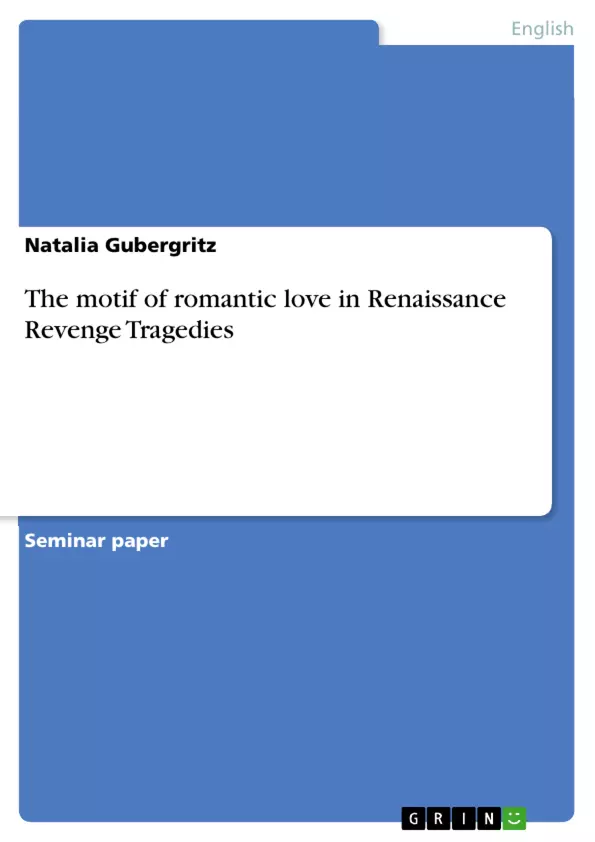The concerns of civilized human society from the beginning on until our days have not changed much. The basic problems of mankind and therefore the basic topics literature was written about are religion, love, family and war. English Renaissance drama is no exception to that. One of the most fascinating genres of Shakespeare’s contemporaries is the Revenge Tragedy. It combines revenge plots with love matters and confronts all this with the structure and beliefs of society. One of the motifs the Revenge Tragedy depends on in order to remain absorbing for the audience is the motif of romantic love. Hence this will be the topic of the paper at hand. Further on I will discuss the different aspects of romantic love and analyse their status in Renaissance society and also the representations of this aspects in three of the most important Revenge Tragedies of that time.
At first I will look on how love was seen in Renaissance society, and in which way matters of marriage were settled. This topic will be regarded deeper in the second chapter, where the approach to love and marriage will be exemplified on the tragedies. The problem of marriage, particularly unequal and secret marriage will be analysed in John Webster’s The Duchess of Malfi. Afterwards I am going to compare the play to Thomas Kyd’s The Spanish Tragedy and see how Kyd handled the Problem of unequal relationships. In chapter 3.3 one of the most important plays in literary history will be analysed on the love relationships of its main characters. In Shakespeare’s Hamlet the romance between the Prince of Denmark and the fair Ophelia is of highest interest to the literary critic. Well, naturally the motif of romantic love does not only include marriage and interpersonal relationships, but also the question of sexuality is quite important. In this paper, I will discuss the dealing with all these topics in the Renaissance tragedies by working closely with the plays in question. As will be found out in the course of the discussion, romantic love, with its different aspects is a crucial motif to every successful Revenge Tragedy.
Inhaltsverzeichnis (Table of Contents)
- Introduction
- Romantic love and the problem of marriage in Renaissance society
- The problem of love and marriage in Revenge Tragedies
- John Webster: The Duchess of Malfi
- Thomas Kyd: The Spanish Tragedy
- William Shakespeare: Hamlet
- The question of sexuality
- Conclusion
Zielsetzung und Themenschwerpunkte (Objectives and Key Themes)
This paper analyzes the motif of romantic love in three key Renaissance Revenge Tragedies: The Duchess of Malfi by John Webster, The Spanish Tragedy by Thomas Kyd, and Hamlet by William Shakespeare. It aims to understand the role of romantic love within the context of Renaissance society, particularly in the context of marriage and the complications arising from unequal or forbidden relationships. The paper also explores the significance of sexuality within these plays.
- The portrayal of romantic love in Renaissance society and its complexities, particularly in relation to marriage
- The problem of unequal or forbidden love and its tragic consequences in Revenge Tragedies
- The impact of societal expectations and conventions on romantic relationships
- The role of sexuality in shaping the characters' actions and motivations
- The connections between romantic love and the themes of revenge and justice
Zusammenfassung der Kapitel (Chapter Summaries)
The first chapter introduces the concept of romantic love as a significant motif in Renaissance Revenge Tragedies. It also establishes the historical and social context of love and marriage during this period, highlighting the importance of social status, family lineage, and patriarchal expectations in shaping romantic relationships.
The second chapter focuses on the complexities of love and marriage within the Revenge Tragedy genre. It analyzes John Webster's The Duchess of Malfi, exploring the tragic consequences of an unequal marriage and the societal condemnation surrounding such relationships. The chapter also compares The Duchess of Malfi with Thomas Kyd's The Spanish Tragedy, examining how Kyd handles the theme of unequal relationships within his play.
The third chapter delves into the romantic relationship between Hamlet and Ophelia in Shakespeare's Hamlet. This chapter examines the complexities of their love story within the context of the play's broader themes of revenge, betrayal, and madness.
Schlüsselwörter (Keywords)
This paper explores the motif of romantic love in Renaissance Revenge Tragedies, focusing on themes of marriage, societal expectations, patriarchal structures, forbidden relationships, unequal unions, the role of sexuality, revenge, and justice. Key works analyzed include The Duchess of Malfi, The Spanish Tragedy, and Hamlet.
- Quote paper
- Natalia Gubergritz (Author), 2008, The motif of romantic love in Renaissance Revenge Tragedies, Munich, GRIN Verlag, https://www.grin.com/document/412616



